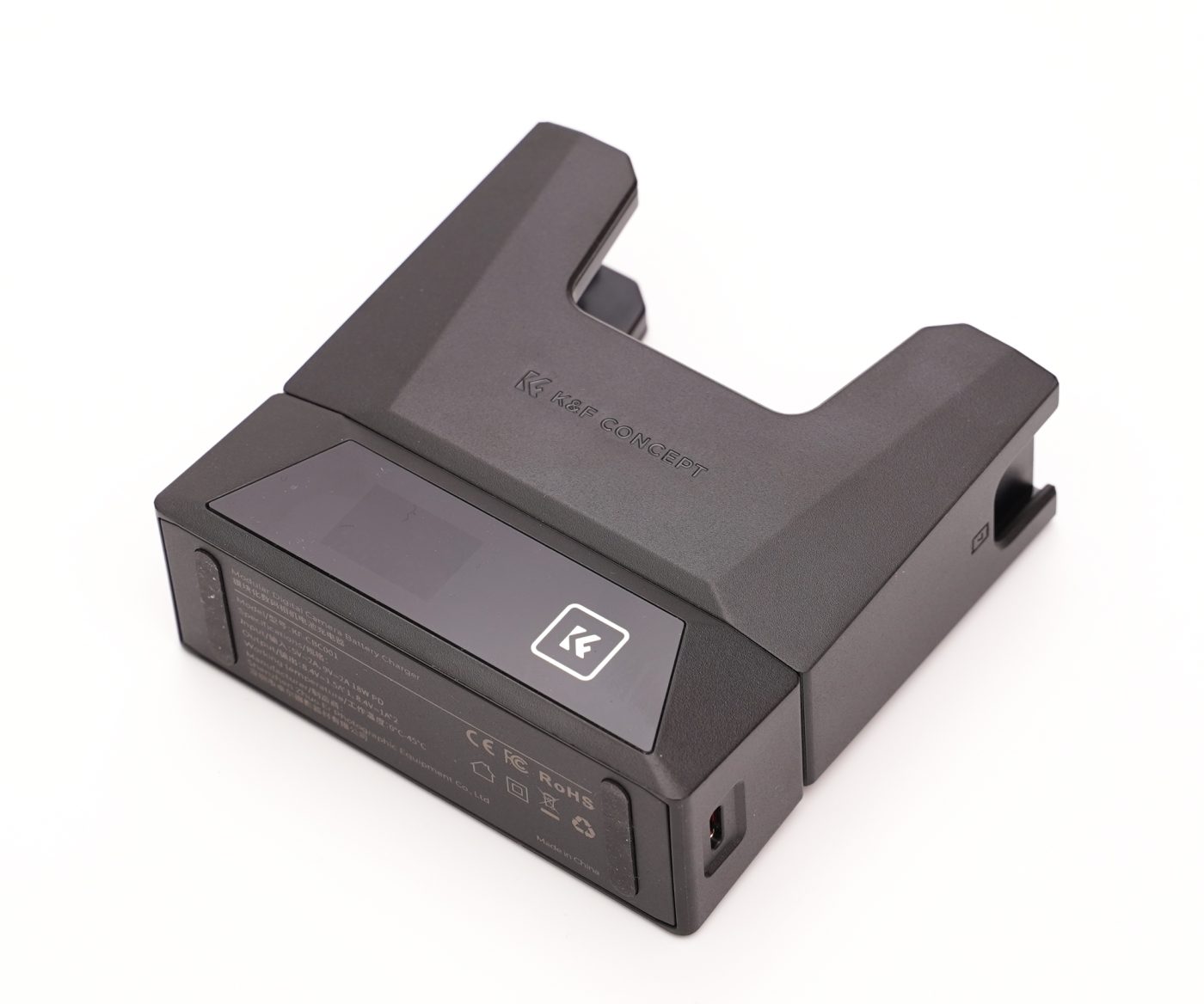In this article, I am reporting on my tests with K&F CONCEPT’s 18W dual fast charger and NP-FZ100 batteries for Sony cameras.
Most cameras released in recent years offer direct charging via USB-C. This is cheaper for the manufacturer but has severe limitations: you can only charge one battery at a time, and you cannot use the camera while it’s charging.
This is why most people quickly purchase an external charger, often alongside extra batteries. Many such chargers appear like an afterthought when purchasing batteries: they are often cheap-looking and slow to charge. After-market batteries are also all over the place, some making bold claims as to their capacity, others having high discharge rate, etc.
This is why I was happy when K&F CONCEPT proposed to send me a set of two batteries and a high-power charger for testing.
After a month of testing, let’s see how the batteries compare and how the charger performs.
This post is NOT SPONSORED, but all Amazon links are affiliate links and will help support this site.
What You Get
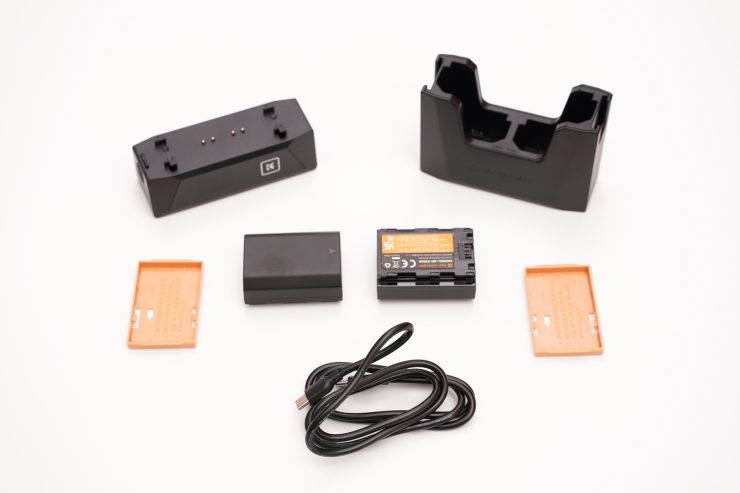
A single Sony-branded replacement battery costs around $80 on Amazon. Meanwhile, K&F CONCEPT’s 18W dual fast charger, along with two batteries, costs around $58, with coupon codes or other rebates often available. That’s a big difference.
A Sony NP-FZ100 battery is rated at 2280 mAh. K&F CONCEPT’s batteries are specified at 2600 mAh. On paper, these batteries are thus higher-capacity on the order of 15%. I also own Neewer batteries (about $45 per pair), rated at 2280 mAh like the Sony, that I’ll be testing alongside the K&F CONCEPT.
Charger
The charger is very nice. It’s a modular design, with a base providing power and information, and the top being replaceable depending on the camera brand. K&F CONCEPT sell chargers for Sony, Canon and Nikon.
The charger is powered via USB-C and comes with a cable. To perform at its peak, it requires a wall brick that’s powerful enough (the recommended rating is 9V / 2A for a total of 18W). I tried it with a low-power brick (5V / 2A) and charging appeared unstable, with the screen flickering a few times. The USB-C port is on the base, on the opposite side to a lever to separate the base from the top.
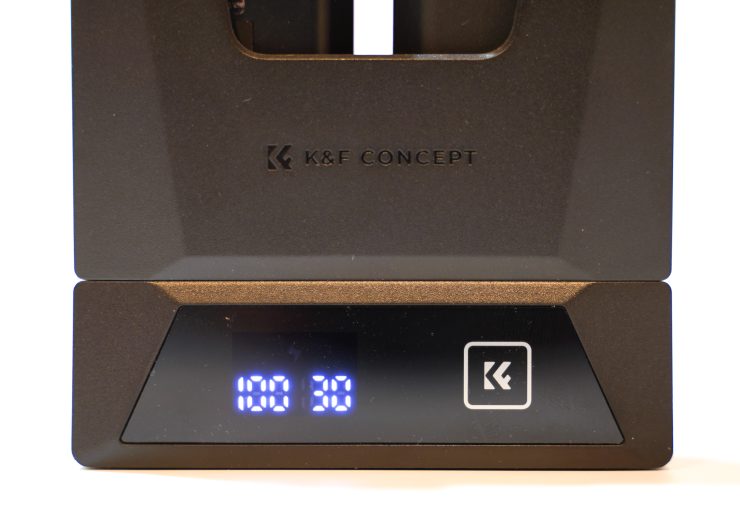
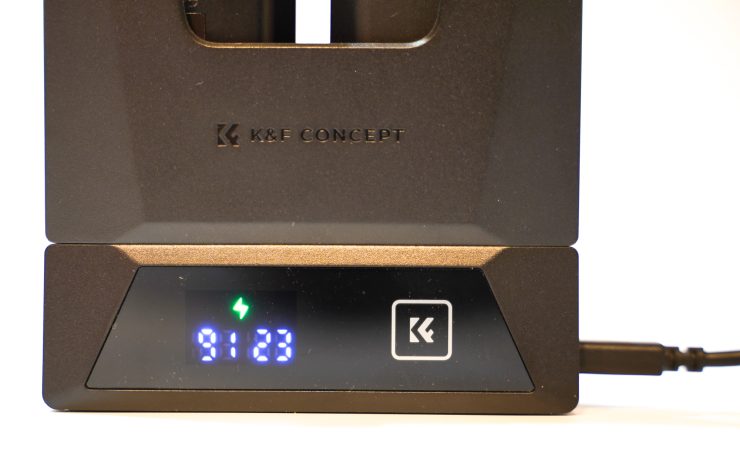
The charger is nicely weighted and very stable. The bottom displays charge levels in percentage for each battery individually, even if the charger isn’t plugged (taking power from the batteries to do so). When plugged, it adds a green lightning bolt to show that it’s charging.
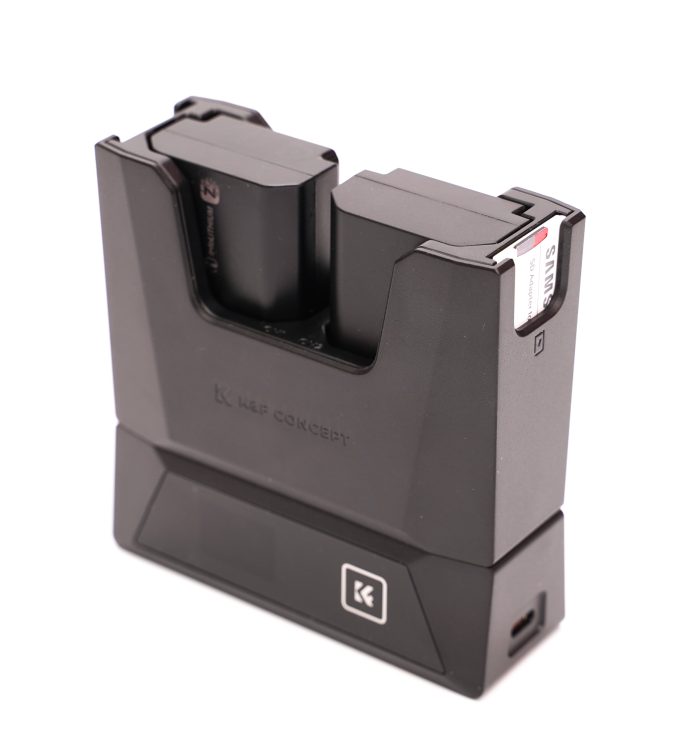
The top offers two charging slots. On each side is also an SD card storage slot. These do not connect to anything, but let you keep your memory cards handy. A nice touch.
The charger adapts the charging speed depending on the charge level. Below 60%, it charges at approximately 2% per minute, about double what my Sony camera reaches, and almost three times as fast as my Neewer charger. Above 60%, the speed decreases to preserve battery health.

Fully charging a battery takes a little over an hour. This is more than twice as fast as when the battery is charged in-camera or with my Neewer charger.
The K&F CONCEPT charger also manages the last few percents of charging better than the Neewer charger (but similar to in-camera charging). Indeed, when charging with the Neewer charger, when inserting a battery in the camera, it displays 100% but quickly drops by a few percents, typically 94-95%. Power drop is more linear afterwards. This does not happen with the K&F CONCEPT charger: the power drops linearly starting at 100%. Furthermore, when charging a battery with the Neewer charger and then inserting it in the K&F CONCEPT charger, the latter reports incomplete charging, also showing 94-95% state of charge. The K&F CONCEPT thus appears more accurate.
Chargers which go too fast tend to damage batteries, often by overheating. This was not the case with the K&F CONCEPT charger: the batteries remained only slightly warm, never hot.
Batteries
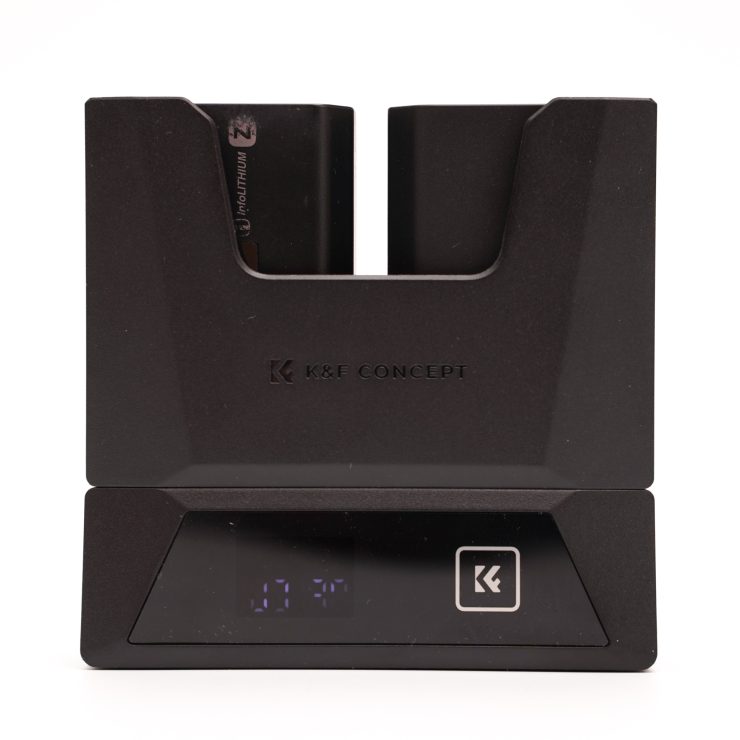
The two batteries supplied with the charger are physically similar to the original Sony. They have the exact same size and insert properly in the camera. Their weight is 80g, whereas the Sony is 83g and the Neewer is 76g.
The K&F CONCEPT batteries ship with a simple plastic cover. This is welcome as some carriers and airlines are now wary of unprotected Li-Ion batteries.
Video Shooting Test
To test the actual capacity of the batteries, I used the same method that has been used before here. The goal is to drain the batteries as quickly as possible, and the best way to do this in camera is to shoot video continuously.
For the test, I used a Tamron 70-180mm F2.8 lens with the Sony A7C on a tripod. The camera was set to 4K video mode with image stabilization on, focusing on a tree branch moving in the wind, ensuring that the camera would constantly refocus. The rear LCD was on at all times. I recorded how long it took to drain the batteries. I tested each of the batteries I have on hand. The Sony and Neewer batteries are a few years old. The table below summarizes the results.
| Sony | K&F CONCEPT | Neewer | |
| Time to 0% Power (1) | 2 hours, 46 minutes | 2 hours, 31 minutes | 1 hour, 41 minutes |
| Time to 0% Power (2) | – | 2 hours, 37 minutes | 1 hour, 52 minutes |
Unsurprisingly, the Neewer batteries do not hold as much power as the original Sony (this is supported by my experience using them). The good news is that the K&F CONCEPT batteries were very close to the Sony. In fairness, the Sony battery is a few years old so differences might be larger with a new battery. Note that this test is not statistically perfect, given the small sample size.
In The Camera
By experience, the Neewer batteries’ state of charge typically drops really quickly around 20%. Once I see this charge level, I know it’s time to change the battery because it will die soon. This does not happen with the Sony battery.
So far, I have not observed that behavior with the K&F CONCEPT batteries either. Their discharge is linear, even at lower charge levels.
The camera never reported any battery error during my time with the K&F CONCEPT. I never observed this problem with the Neewer batteries either.
Out Of The Camera (Self-Discharge Rate)
Testing the self-discharge rate is easy, but takes some time. I charged, at the same time, one Sony, one Neewer and one K&F CONCEPT battery, all using the K&F CONCEPT charger. I put them aside for four weeks in a cool area, side by side. I then inserted them in-camera and read the measured power level:
- Sony: 97%
- K&F CONCEPT: 99%
- Neewer: 93%
The Sony battery, expected to be the gold standard here, did a bit worse than the K&F CONCEPT. This is great news for the latter. Despite the Sony being older, which can explain some of the difference, the K&F CONCEPT battery is objectively near-perfect in this test, doing better than the (also older) Neewer battery.
Should You Buy Them?
Should you buy the K&F CONCEPT dual fast charger and NP-FZ100 batteries? To me, the answer is yes.
The charger is well made, powerful and fast, and appears more accurate than other alternatives. This is probably safer for the batteries in the long term. It is, however, bulkier than more travel-friendly options.
The batteries performed well in my tests, closely matching the performances of the OEM Sony battery I tested. They score a bit below their reported capacity, but close enough that differences could very well be caused by the test uncertainty.
At three-quarters of the price of a single Sony battery, you’re getting two dependable batteries and a good-quality charger. This is, by any measure, a great price.
Given the minimal difference in observed capacity between the K&F CONCEPT and Sony batteries, it’s easy to recommend the former for anyone, be they hobbyists or professionals. There should be no practical difference in everyday use.
The K&F Concept charger and batteries can be purchased via Amazon or directly from the K&F Concept website.

